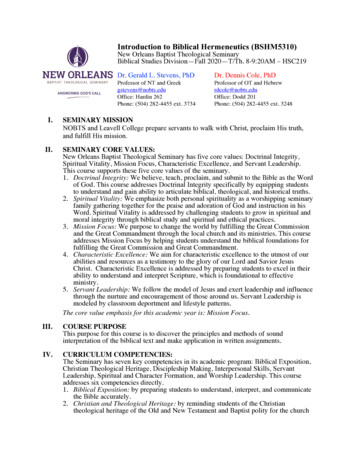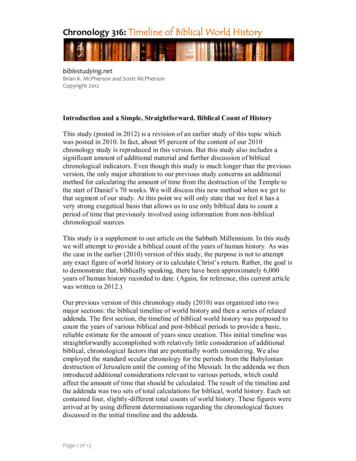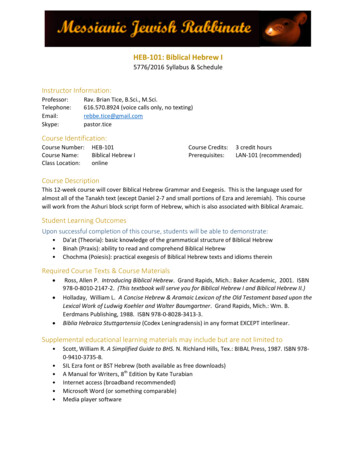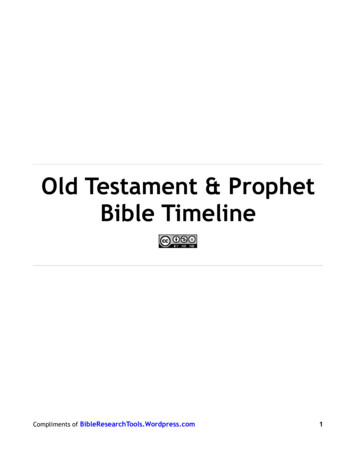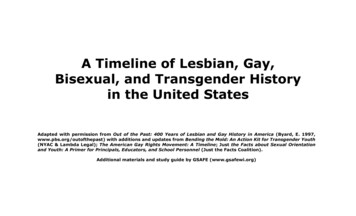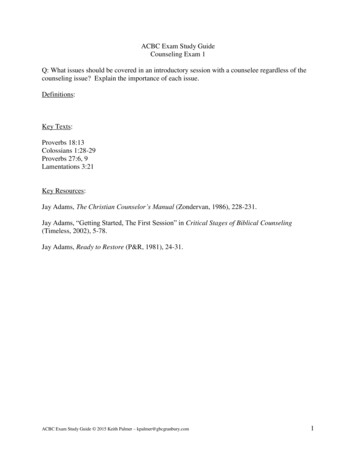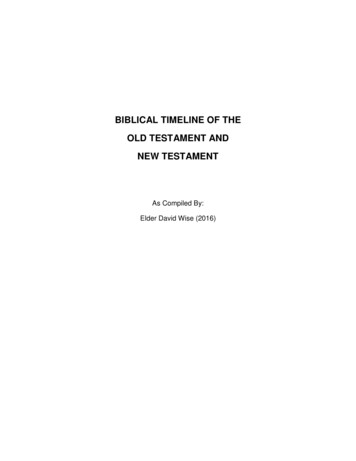
Transcription
BIBLICAL TIMELINE OF THEOLD TESTAMENT ANDNEW TESTAMENTAs Compiled By:Elder David Wise (2016)
This page is intentionally left blank.
BIBLICAL TIMELINE OF THEOLD AND NEW TESTAMENTTABLE OF CONTENTSPreface1OLD TESTAMENTCreation to Canaan5Period of the Judges9Kingdom PeriodEstablishment of the United Kingdom13The Divided Kingdom14The Last Days of Judah18Babylonian Captivity of Judah19Judah’s Return to Jerusalem20Three Exiles of Judah21Three Returns of Judah22Verse Cross Reference – 1 Samuel to Nehemiah23Prophets of the Old Testament3370 Weeks of Daniel Prophecy47NEW TESTAMENTIsrael During the Time of Jesus – Map54Harmony of the Gospels55Events of the Early ChurchSummary Timeline67Detailed TimelinePentecost to Herod’s PersecutionstPaul’s 1 Missionary JourneyPaul’s 2nd6972Missionary Journey74Paul’s 3 Missionary Journey78Paul’s Travel to Rome81Paul’s Roman Imprisonment to Apostle John’s death84rdNEW TESTAMENT BOOKSAuthorship of New Testament Books – Summary Timeline89Detail of Authorship of New Testament Books91
This page is intentionally left blank.
PREFACEI have compiled these timelines, diagrams, and study outlines during my personal Bible studies over thelast three years, when I first began to study the Bible in a devoted manner. Therefore, they wereformatted and organized in a manner for me to understand and recollect the information I had studied. Iam a visual learner and a very systematic outliner, so I structured the information in a manner that waseasy for me to follow the events, and I hope they will be easy to follow for the reader as well. I sharedthese outlines and timelines with the church I serve, as well as with some friends in general and friends inthe ministry, who I thought might benefit from the content, but also could critique my information. Mygood friend – Elder Josh Winslett – has encouraged me to present this information for other people tobenefit from as well, and this work is the result of my reluctant acceptance of that request. I still considermyself a novice in the scriptures, and I am learning new treasures from the word of God every day.Consequently, my personal notes that have produced this work are being refined every day as well. I’msure there will be a need to update this information as my understanding of scripture improves as theyears go along. Regardless, I do hope my timelines, notes, and the rest of the content that I havecompiled thus far can benefit more Bible students that use this work.I have attempted to present a “biblical”, rather than “historical” timeline of the Bible. I have tried toconstruct these timelines from “biblical benchmarks” that certain scriptures provide us, rather than justtaking the standard secular, historical timeline. For example, in 2 Kings 8:16, we’re told that whilethJehoshaphat was still king, Jehoram began to reign in the 5 year of Joram, son of Ahab. So now we areable to cross reference Jehoram’s reign in Judah with Joram’s reign in Israel and conclude thatthJehoshaphat and Jehoram were co-regents and Jehoram’s reign begin in the 5 year of Joram. Andcertain time periods in scripture constrict the timeline further, such as 1 Kings 6:1 stating that the buildingof Solomon’s temple began exactly 480 years after Israel’s Exodus from Egypt. This time period wouldconstrict the time of judges to about 300 years, rather than “about 450 years” that seems to be implied inActs 13:20.Scripture is perfectly and divinely inspired. God inspired the word of God in a manner to give His childrenevery single thing that we need to know here in this world until we get to heaven. With that said, I wouldcontend that every single date that is crucial to our understanding of scripture, particularly those that dealwith the fulfillment of a biblical prophecy, has been precisely given to us in the word of God. Those“endless genealogies” that we often skip over is the chief evidence in the scriptures that confirm to thebeliever a young Earth theory. We may disagree about the date that Jacob’s family moved to Egypt, but Ican prove from the scriptures that Adam was created by God precisely 2,238 years before that date.Therefore, the Earth is not six billion years old as commonly accepted in secular circles, but rather a littleover six thousand years old, as proven by the scriptural dates in the book of Genesis.Interestingly though, as we compare scripture, you will also notice there are many genealogies that aregiven without the precise dates of the birth. God again puts the emphasis in the right place in Hisrevelation of scripture. The age that David, Solomon, and the rest of David’s lineage had their sons arenot revealed, but we do have a complete lineage of David. So the age of David when Solomon was borndoes not matter to our understanding of scripture, but the fact that Jesus Christ was the natural “son ofDavid” through his lineage is confirmed in the continuous genealogy of David that we have revealed inmultiple places. The scriptural emphasis in this case is not on the years, but on the actual lineage ofDavid confirming that Jesus was born of the tribe of Judah, confirming another prophecy.1
The prophecy of the seventy weeks of Daniel is maybe the best example that scripture was inspired insuch a manner to give us all the information we need to know and not any more. We are given theprecise secular date of the beginning marker in this biblical prophecy – the decree to rebuild Jerusalemthwas given in the 7 year of the Persian King Artaxerxes I. We can confirm this date in secular history.Also, the most precise date in the New Testament is the beginning of John the Baptist’s personal ministry:“Now in the fifteenth year of the reign of Tiberius Caesar, Pontius Pilate being governor of Judaea, andHerod being tetrarch of Galilee, and his brother Philip tetrarch of Ituraea and of the region of Trachonitis,and Lysanias the tetrarch of Abilene, Annas and Caiaphas being the high priests, the word of God cameunto John the son of Zacharias in the wilderness.” (Luke 3:1-2) Not only does scripture give us theprecise year of the Roman Emperor’s rule to confirm this date, but it also gives us the governor of Judea,the three tetrarchs in the region, and the current high priests at that time. This specific information isgiven principally to allow the Bible student to confirm the precise date of this event for us to see thefulfillment of the prophecy of seventy weeks in Daniel of when the “Messiah the Prince” would berevealed.Therefore, suffice to say, if we needed to know the length of Shamgar’s judgeship, scripture would haverevealed it. If we needed to know the exact date of Peter’s ministry to Cornelius, scripture would haverevealed it. The date in which Peter went to Cornelius does not matter to our understanding of scripture;the point that matters from that account is that the door of the gospel was opened to the Gentiles, andthat encounter proved that God has a people “in every nation”.It’s interesting to me that not a single book in the Bible indicates “when” that book was composed(although some prophecies do give specific dates and such). If we needed to know who wrote Hebrewsand what year it was written, then it would have begun in this manner – “Paul, an apostle of Jesus Christ,in the tenth year of the reign of Nero Claudius Caesar ” But the content of the canon of the NewTestament is God’s intended focus, not the writer or the date in which the writer actually wrote the book.Therefore, I present the most reasonable dates for the penning of the books of the New Testament booksbased on my personal studies. I trust the reader will consider the information that I have presented andassess the accuracy or validity of it independently for themselves.I hope the information offered here will be profitable to you in your studies of the word of God. If nothingelse, I hope this will stir the reader to be as the noble Bereans and to assess the information I havepresented and determine for yourself if these things are so – “And the brethren immediately sent awayPaul and Silas by night unto Berea: who coming thither went into the synagogue of the Jews. These weremore noble than those in Thessalonica, in that they received the word with all readiness of mind, andsearched the scriptures daily, whether those things were so.” (Acts 17:10-11)“Consider what I say; and the Lord give thee understanding in all things.” (2 Timothy 2:7)Elder David Wise2
OLD TESTAMENT3
This page is intentionally left blank.4
OLD TESTAMENTCREATION TO CANAAN3905Adam is created by God on the sixth day3775Birth of Seth (130 years from Adam’s creation to the birth of Seth – Gen. 5:3)3670Birth of Enosh (105 years from Seth to the birth of Enosh – Gen. 5:6)3580Birth of Kenan (90 years from Enoch to the birth of Kenan – Gen. 5:9)3510Birth of Mahalalel (70 years from Kenan to the birth of Mahalalel – Gen. 5:12)3445Birth of Jared (65 years from Mahalalel to the birth of Jared – Gen. 5:15)3283Birth of Enoch (162 years from Jared to the birth of Enoch – Gen. 5:18)3218Birth of Methuselah (65 years from Enoch to the birth of Methuselah – Gen. 5:21)3031Birth of Lamech (187 years from Methuselah to the birth of Lamech – Gen. 5:25)2849Birth of Noah (182 years from Lamech to the birth of Noah – Gen. 5:28)2249Beginning of the Flood (600 years from Noah's birth to the beginning of the Flood – Gen. 7:6)o 1,656 years – Total from Adam's creation to the Flood2247Birth of Arphaxad (2 years from the Flood to the birth of Arphaxad – Gen. 11:10)2212Birth of Salah (35 years from Arphaxad to the birth of Salah – Gen. 11:12)2182Birth of Eber (30 years from Salah to the birth of Eber – Gen. 11:14)2148Birth of Peleg (34 years from Eber to the birth of Peleg – Gen. 11:16)2118Birth of Reu (30 years from Peleg to the birth of Reu – Gen. 11:18)2086Birth of Serug (32 years from Reu to the birth of Serug – Gen. 11:20)2056Birth of Nahor (30 years from Serug to the birth of Nahor – Gen. 11:22)2027Birth of Terah (29 years from Nahor to the birth of Terah – Gen. 11:24)1957Birth of Abram (70 years from Terah to the birth of Abram – Gen. 11:26)oo292 years – From the Flood to Abram's birth1,948 years – From Adam's creation to Abram's birth1882Abrahamic Covenant (Abram was 75 years old when God made the covenant – Gen. 12:4)1857Birth of Isaac (100 years from Abraham to the birth of Isaac – Gen. 21:5)1797Birth of Jacob (60 years from Isaac to the birth of Jacob – Gen. 25:26)1667Jacob moves to Egypt (Jacob was 130 years when he moved his family to Egypt – Gen. 47:28)oo290 years – From Abram's birth to Jacob entering Egypt2,238 years – From Adam's creation to Jacob entering EgyptLife of Joseph (1706-1596)oooooo17 years old (Gen. 37:2) when he is sold to the Midianites who take him to Egypt30 years old when he becomes 2nd in command in all of Egypt (Gen. 41:46)Then, 7 years of plenty storing up for the famine (Gen. 41:47)Then, 2 years into the famine Joseph’s brothers come for food (Gen. 45:6)Then, 17 years after Jacob comes into Egypt, Jacob dies (Gen. 47:28), so Joseph is 56when Jacob dies (year 1650)Then, 54 more years Joseph lives in Egypt, and Joseph dies at the age of 110 (Gen.50:26)5
OLD TESTAMENTCREATION TO CANAAN1667 – 1452a1452215 years of Israel’s “Egyptian Bondage” from Jacob entering Egypt to the ExodusMoses leads Israelites in “The Exodus” out of Egypt1452 – 141240 years of wandering in the wilderness (Num. 14:34)1412Moses dies (Deut. 34:5-8), and Joshua leads Israel over the Jordan River into Canaan1412 – 1407b5 years to conquer Canaan1407 – 1382c25 years - Joshua judges in Canaan1382 – 1363d20 years - From Joshua’s death till all of Joshua’s generation dieda.Period of Israel’s Egyptian Bondage: 430 / 400 / 215 years?There are conflicting time periods in scripture regarding the Egyptian bondage of Israel. A 430 period appearsto referenced in Exod. 12:40 and Gal. 3:17, a 400 year bondage in Gen. 15:13 and Acts 7:6, but genealogies inscripture constrict the time in Egypt to only 350 years. So what was the actual time period of Israel’s Egyptianbondage?In Exod. 12:40-41, it says the “sojourning” of the children of Israel was 430 years. Immediately after thecovenant is given to Abram in 1882 (Gen. 12:1-8), Abram goes down to Egypt to “sojourn” there due to a famine(Gen. 12:10). The time period from the beginning of Abram’s Egyptian “sojourn” until the Exodus was 430 years(1882-1452).In Gal. 3:17, the Apostle Paul is comparing the Mosaic law to the Abrahamic covenant. Since the clausecontaining 430 years is offset by commas, it is providing a further description of the law and could easily beoffset by parentheses to make it easier to read. So this verse could be read as: “And this I say, that thecovenant (that was confirmed before of God in Christ), the law (which was after 430 years after) cannotdisannul, that it should make the promise of none effect”. He states that the Mosaic law which came after thecovenant “cannot disannul” (it doesn’t override or supersede) the Abrahamic covenant. And he even gives usthe exact time that the law was given after the covenant was made. This scripture is actually giving us the exacttime period of when the Abrahamic covenant was given until when the Mosaic law was given. The law wasrdgiven unto Moses in the 3 month after the Exodus when they arrived at Mount Sinai (Exod. 19:1), so essentiallythe time of the Abrahamic covenant was 430 years before the Exodus. We know from the Genesis accountsthat the time period from the Abrahamic covenant when he was 75 until Jacob enters Egypt was 215 years(1882-1667). So that means the time period from the entering of Egypt until the giving of the law on Sinai wasanother 215 years. From this text, Paul actually confirms a 215 year Egyptian bondage from his proof of the 430year time lapse from the confirming of the Abrahamic covenant until the giving of the Mosaic law on Mt. Sinai.In Acts 7:6, Stephen quotes from the Genesis 15 account in his sermon that a nation would “bring them intobondage, and entreat them evil 400 years”. He is quoting from the account in Genesis, so if we understand thescripture in Genesis, this covers Acts 7:6 too. (Also, since Gen. 15:13 and Exod. 12:40 appear to both introducedifferent time periods of the bondage, it’s interesting that Stephen in a New Testament sermon ignores the 430years in Exod. 12:40 and instead quotes scripture from the 400 years in Gen. 15:13. This is sufficient to showthat the New Testament church didn’t consider the 430 years of sojourning in Exod. 12:40 to be the literal timeperiod of the bondage.)In Gen. 15:13, Abram was told his “seed” would be “afflicted” for 400 years by the nation they would be inbondage to, which was eventually Egypt. The affliction of Abraham’s seed by the Egyptians began from the“bondage” of Hagar’s (an Egyptian) son, Ishmael, when she was “cast out” at the time of Isaac’s weaning (Gen.21:8-11) because Ishmael (an Egyptian by his maternal birth) “persecuted” (Gal. 4:29) Isaac, the promised son.6
OLD TESTAMENTCREATION TO CANAANa. Period of Israel’s Egyptian Bondage: 430 / 400 / 215 years? (continued)Assuming Isaac’s weaning occurred at 5 years old this would have been 30 years after the Abrahamic covenant(1882), so he would have been cast out in roughly 1852. Assuming an Exodus date of 1452, it would have been400 years from Ishmael’s antagonism and affliction of the seed of Abraham, Isaac, until the liberation fromEgyptian bondage. Hagar (an Egyptian, and mother of Ishmael) is presented as an allegory for the “bondage” ofthe law (Gal. 4:22-31). Ishmael’s hand was to be against every man (Gen. 16:12), but there is no scripturalevidence of hostility towards Abraham’s seed until this event in Gen. 21:9, which would coincide with thebeginning of Egyptian “affliction” of the seed of Abraham.The maximum time period of the Egyptian bondage based on genealogies provided in scripture is 350 years.Kohath, the son of Levi, was born before Levi came into Egypt (Gen. 46:8,11) and died at age 133 (Exod. 6:18).Amram, the son of Kohath and father of Moses, was 137 at death (Exod. 6:20). And Moses, the son of Amram,was 80 at the time of the Exodus (Exod. 7:7). If Kohath was one year old when he entered Egypt, and Moseswas born in the last year of Amram’s life (which is quite unlikely) the absolute maximum time period of thebondage is 350 years. However, a 215 bondage period fits quite nicely with this genealogy account, allowing fornormal time of birth and length of life. Also see Exod. 6:16-20, 1 Chr. 6:1-3, 1 Chr. 23:12-20 to confirm there isno skip in the generations of the genealogy; Moses is the grandson of Kohath and great-grandson of Levi.Abram was also promised his seed would return out of bondage in the “fourth generation” (Gen. 15:16), andMoses was the fourth generation from Jacob (Levi - Kohath - Amram - Moses), who first entered Egypt.It appears to me the genealogy hurdle is too much to allow for the standard 400 years Egyptian bondage (andwe can’t just start ignoring genealogies and say that some skipped a few people because the genealogy ofJesus in Matt. 1 is one of the most important sections of scripture there is; if we question one genealogy ofLevi’s descendants, that puts into question the genealogy of Jesus Christ too, and we certainly don’t want toquestion that.) Since the 430 and 400 year references can be reconciled with events in the life of Abraham, andsince Paul’s writing in the New Testament independently presents a 215 year bondage (especially consideringPaul was probably one of the foremost Old Testament scholars in Judaism at that time), and also sinceJosephus who had access to many ancient documents and the thinking of that time presented a 215 yearbondage, I believe that the use of 215 year Egyptian bondage from Jacob’s arrival to the Exodus is the mostappropriate.b.Caleb was 40 when he initially spied out the land (Josh. 14:7), 40 years in the wilderness (Num. 14:34), andthen was 85 when the land was divided (Josh. 14:10) after the conquest was complete, so there was 5 yearsfrom the entering of Canaan until the land was dividedc.Joshua was a “young man” at the Exodus and Canaan expedition (Exod. 33:11, Num. 11:28); Joshua and Calebwere likely the same age, meaning Joshua was also 85 when the Canaan conquest was complete (Josh. 14:10),so he likely was still the leader of the Israelites for another 25 years before he died at age 110 (Josh. 24:29)d.Israel was faithful to the Lord until Joshua’s generation died, then they turned to other gods (Josh. 24:31; Judg.2:7,10,11-19); this time period is reasonable because the generations of Israel were usually counted from 20years old and upward (Num. 14:29, Num. 1:20,22, etc.) Judges 17-21, “when there was no king in Israel”, would be during this period. These chapters wereearlier than other periods chronicled in the book of Judges because grandchildren of Moses andAaron were still alive:o Judg. 18:30 - Jonathan, son of Gershom, grandson of Moses (all of Gershom’s children arenot listed in scripture, only that “Shebuel was chief” - 1 Chr. 23:16)o Judg. 20:28 - Phinehas, son of Eleazar, grandson of Aaron (1 Chr. 6:3-4)7
This page is intentionally left blank.8
OLD TESTAMENTPERIOD OF THE JUDGESYear13631355Gentile OppressionJudges of Israele1363-13558 years Mesopotamian oppression, Judges 3:81355-13151) Othniel as judge, Judges 3:7-1140 years of rest, Judges 3:1113151315-129718 years Moabite oppression, Judges 3:14Book of Ruth12971297-12172) Ehud as judge, Judges 3:12-3080 years of rest, Judges 3:3012171213120011931217-1213Possible Philistine oppression, Judges 3:311213-119320 years Canaaniteoppression, Judges 4:31217-12133) Shamgar as judge, Judges 3:31(no time period given, estimated 4 year judgeship)1200-11937 years Midianite oppression, Judges 6:19
OLD TESTAMENTPERIOD OF THE JUDGESYearGentile OppressionJudges of Israel1193e1193-115340 years the land had rest, Judges 5:31, 8:28- 4) Deborah as judge, Judges 4:4‒5:31(with Barak as general, Judges 4:6‒5:31)- 5) Gideon as judge, Judges 6:11‒8:3511531153-11506) Abimelech, 3 years as ruler, Judges 9:1-5711501150-11277) Tola, 23 years as judge, Judges 10:1-2112711231127-108740 years of Philistinewar and oppression,Judges 13:11127-11058) Jair, 22 years as judge,Judges 10:351123-110518 yearsAmmonite war,Judges 10:18110711051105-1099 9) Jepthah, 6 years asjudge, Judges 11:1‒12:710991099-1092 10) Ibzan, 7 yearsas judge, Judges 12:8-101127-108713) Eli, 40 yearsas priest and judge,1 Sam. 4:181107-118714) Samson,20 years aswarrior judge,Judges 15:20,16:3110921092-1082 11) Elon, 10 yearsas judge, Judges 12:11-12108710821082-1074 12) Abdon, 8 yearsas judge, Judges 12:13-151074101087-105515) Samuel, prophetand judge all the daysof his life, 1 Sam. 7:15
OLD TESTAMENTPERIOD OF THE JUDGESe.Period of the JudgesIf all of the Gentile oppressions and Israel’s judgeships (excluding Samuel and not knowing the length of Shamgar’sjudgeship) occurred consecutively, then the time period from the beginning of the 8 year Mesopotamian oppression tillthe end of Eli’s 40 year judgeship would be 410 years. However, scripture dictates the time period from the Exodusuntil the beginning of the building of Solomon’s temple to be 480 years (1 Kg. 6:1); 410 years plus just the three 40year periods of the wandering in the wilderness, Saul’s reign, and David’s reign, puts the time period of the judges wellover that mark. So obviously, some of the oppressions and judgeships were simultaneous, particularly the threeunique judges of Eli who was both priest (1 Sam. 1:9) and judge (1 Sam. 4:18), Samson who was a warrior judgeparticularly against the Philistines during their 40 years of oppression (Judges 14-16), and Samuel who was a prophet(1 Sam. 3:20) and judge (1 Sam. 7:15). These three judges are distinguished in their own unique judgeship lineage. Itappears that Samuel became judge at the time of the death of both Samson and Eli. He becomes a judge almostimmediately upon the death of Eli (1 Sam. 7:15), and he leads Israel into battle against the Philistines (1 Sam. 4-7) andafter their defeat (1 Sam. 7:14), there is no more mention of war, particularly with the Philistines, in Samuel’s judgeship.So this would coincide with ending of the 40 years of Philistine oppression, and it’s likely their armies would have beenquite decimated if this battle occurred after Samson killed so many Philistines in his death (Judges 16:30-31).In Judges 11:26, Jephthah questions the king of Ammon why they have not recovered these disputed cities during thetime that Israel had dwelt in those cities until that current time, a period he presents as 300 years. Israel took Heshbonin Num. 21:25-28, and the tribe of Gad built Aroer in Num. 32:34, both just a few years before the Israelites entranceinto Canaan. However, the children of Gad were required to help the rest of Israel conquest the land of Canaan whichwas then divided among the tribes in 1407. Assuming the tribe of Gad moved back to Aroer soon after in 1406 and thishappened in the first year of Jephthah’s judgeship in 1105, that would be almost exactly 300 years that Israel hadoccupied the disputed cities up to that point.After estimating Shamgar’s judgeship to be 4 years, the time period of the judges (from beginning of Othniel’sjudgeship until the beginning of the reign of King Saul) is exactly 300 years. 40 years Israel’s wandering in the wilderness 57 years from entering of Canaan until the first judge, Othneil 300 years from Othniel to reign of King Saul 40 years of King Saul’s reign 40 years of King David’s reignth 3 years of King Solomon’s reign (temple construction began in the 4 year of Solomon, 1 Kg. 6:1) 480 years total from the Exodus (1452) to the building of Solomon’s temple (972)11
This page is intentionally left blank.12
OLD TESTAMENTESTABLISHMENT OF THE UNITED KINGDOMYearJudges of IsraelKings of Israel1074e1087-1055Samuel, prophet and judge all the days of his life, 1 Sam. 7:151055 ‒ Saul is anointed as king of Israel by Samuel10551055-1015Saul, 40 years as king, Acts 13:2110151015-975David, 40 years as king, 1 Kg. 2:111015-1013 Ishbotheth (Saul’s son)2 years as ruler over Israel (not including Judah), 2 Sam. 2:10975975-935Solomon, 40 years as king, 1 Kg. 11:42972935972 ‒ Beginning of the construction ofSolomon’s temple935 ‒ Death of Solomon and Division of the Kingdom* Jeroboam leads rebellion of northern 10 tribes of Israelf13
OLD TESTAMENTTHE DIVIDED ophets–IsraelIsrael935-918Rehoboam, 17 years935-913Jeroboam, 22 years917-915 Abijam, 3 years914-874Asa, 41 years913-912 Nadab, 2 years912-889Baasha, 24 years889-888 Elah, 2 years888 Zimri, 7 days889/888888-883, 6 yearsCivil War between Omri/Tibni888-877Omri, 12 years877877-856Ahab, 22 years874Elijah’s Ministry874-850Jehoshaphat, 25 yearsElisha’sMinistry858856858-857Ahaziah, 2 years14
OLD TESTAMENTTHE DIVIDED elIsrael874-850 Jehoshaphat857-846Jehoram, 12 years853Elijah’sMinistry853-846 Jehoram, 8 years850847/846846 Ahaziah, 1 year845-840Athaliah (queen), 6 years846-819Jehu, 28 years840840-801Joash, 40 yearsElisha’sMinistry818818-802Jehoahaz, 17 years804/803801804-789 Jehoash, 16 years803-775 Amaziah, 29 years801-761Jeroboam II, 41 years798798-747Uzziah, 52 years78915
OLD TESTAMENTTHE DIVIDED ��Israel801-761Jeroboam II, 41 years803-775Amaziah, 29 yearsAmosJonahHosea775798-747Uzziah, 52 yearsJoel761 Zachariah, 6 months760 Shallum, 1 month761/760760-750Menham, 10 years750749748750-749 Pekahiah, 2 years748-733Jotham, 16 years749-730Pekah, 20 yearsIsaiahMicah740730 ‒ 1 partial Assyrian exile ofcertain tribes of Israelg733730740-724Ahaz, 16 years730-722Hoshea, 9 years727724722st727-698Hezekiah, 29 years722 ‒ 2 and final Assyrian exileof all the northern ten tribes of Israelh16nd
OLD TESTAMENTTHE DIVIDED KINGDOMf.Division of the KingdomDue to Solomon’s apostasy at end of his reign (1 Kg. 11:1-8), God chose to take away the kingdom from Solomon’sposterity. However due to God’s faithfulness to His servant David, God allows Solomon’s seed (his son, Rehoboam) tomaintain one tribe of Judah (1 Kg. 11:12-13). Eventually, the tribe of Benjamin sides with Judah (1 Kg. 12:21), andthere are two tribes comprising the southern kingdom. God raises up a mighty man of valour in Solomon’s own army,Jeroboam (of the tribe of Ephraim), to start the revolt upon the death of Solomon (see all of 1 Kg. 11-14 forcircumstances leading to the revolt and aftermath). So the unified kingdom of Israel is now split into two kingdomsupon the death of Solomon in 935:1)Judah (Southern Kingdom) Comprised of the 2 southern tribes of Israel, Judah and Benjamin Followed the leadership of Rehoboam, son of Solomon, at the division of the kingdom Capital was Jerusalem (also referred to by its capital Jerusalem, or even Zion/Mount Zion)2)Israel (Northern Kingdom) Comprised of the northern ten tribes of Israel, excluding Judah and Benjamin Also referred to as Ephraim, after its largest tribe and tribe of its founder, Jeroboam Followed the leadership of Jeroboam at the division of the kingdom Capital was Samaria (also referred to as Samaria too)The division of Israel into two separate kingdoms is a very important event to understand what takes place with thechildren of Israel from this point forward. Whereas, all twelve tribes were oftentimes addressed as “Israel” up until 935,now only the northern ten tribes are referred to as “Israel/Samaria/Ephraim”, whereas the other two tribes are nowtypically addressed as “Judah/Jerusalem”, with each having separate kings and leadership.Two Exiles of Israelg.st730 – 1 partial Assyrian exile of IsraelTiglathpileser, king of Assyria, takes some, but not all, of the northern tribes into captivity and carried them back toAssyria in his first successful invasion in 730. He conquers the tribes of Reuben, Gad, Manasseh (1 Chr. 5:25-26),many towns in Dan, and all of Naphtali (2 Kg. 15:29), and then subsequently takes them back into captivity.This date assumes that Pekah, then the king of Israel, was killed by a domestic conspiracy as a result of his lost battleswith Assyria, and Hoshea takes over essentially at the same time, since the conspiracy that killed Pekah is addressedin the verse immediately following the captivity (2 Kg. 15:29 & 30)h.722 – 2ndand final Assyrian exile of all the northern tribes of IsraelIsrael’s capital city of Samaria was besieged by Assyria for 3 years before it fell (2 Kg. 17:5). Finally, Shalmaneser,king of Assyria, breached Samaria and carried all of Israel’s tribes captive into Assyria, into the cities of the Medes (2ththKg. 17:6). This final exile of Israel occurred in the 9 year of Hosea (king of Israel), and 6 year of Hezekiah (king ofJudah). The causes of the captivity are provided right after the description of the captivity, in 2 Kg. 17:7-23 (18:12), inwhich they never departed from the false idol worship established by the founder of the northern kingdom, Jeroboam.No return to their land was promised unto the northern ten tribes of Israel, as a return was promised to the kingdom ofJudah. One of the great mysteries of ancient history is the outcome of the “lost ten tribes of Israel”, but the Bible issilent regarding their fate after their foreign exile to Assyria.17
OLD TESTAMENTTHE LAST DAYS OF JUDAHYear722JudahProphets–JudahProphecies to the Gentile Nations727-698Hezekiah, 29 yearsMicahIsaiah697697-643Manasseh, 55 years642640642-641 Amon, 2 years640-610Josiah, 31 yearsZephaniahNahum627Jeremiah610609609 Jehoahaz, 3 months18 780 ‒ Jonah (to Nineveh) 630 ‒ Nahum (to Nineveh) 586 ‒ Obadiah (to Edom)
OLD TESTAMENTBABYLONIAN CAPTIVITY OF JUDAHYear609JudahProphets–Judah609-598Jehoiakim, 11 yearsBabylonian EmpireJeremiahHabakkuk605iDaniel597605 ‒ 1 Babylonian exileof Judah (including Daniel)605-561Nebuchadne
Harmony of the Gospels 55 Events of the Early Church . Summary Timeline 67 Detailed Timeline . Pentecost to Herod's Persecution 69 Paul's 1st Missionary Journey 72 Paul's 2nd Missionary Journey 74 Paul's 3rd Missionary Journey 78 Paul's Travel to Rome 81 Paul's Roman Imprisonment to Apostle John's death 84 . NEW TESTAMENT BOOKS



